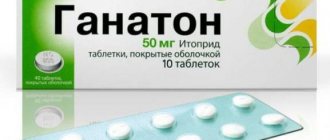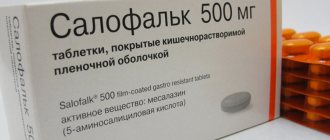Nausea and vomiting in people of any age are natural reactions of the body under certain conditions. These are various poisonings, pathological conditions in the gastrointestinal tract, reactions to certain medications, and stressful situations.
Working with adult patients is easy. They understand their condition and can, if necessary, restrain their natural impulses. With children everything is much more complicated. Their gag reflex is triggered automatically, and it is almost impossible to stop it by force of will.
Nausea and vomiting often make effective treatment difficult. Modern pharmacy offers a variety of drugs that can, if necessary, suppress nausea and the gag reflex. One of the drugs of choice is Cerucal. Parents are interested in what is the dosage of Cerucal for children?
When not to
The medicine has contraindications, so giving it to a child without a doctor’s prescription is dangerous. Children who have:
- epilepsy;
- glaucoma;
- bleeding from the gastrointestinal tract;
- intestinal obstruction;
- pheochromocytoma (a tumor that activates excessive production of adrenaline or norepinephrine);
- extrapyramidal (motor) disorders;
- gastric perforation (for example, with peptic ulcer);
- peritonitis.
And, of course, patients with hypersensitivity to any of its components should not take the medicine. The drug is not prescribed to children under 2 years of age.
With caution, only under the supervision of a doctor and careful monitoring of changes in the child’s condition, the drug is indicated for patients with certain pathologies:
- liver and/or kidney dysfunction;
- bronchial asthma;
- hypertonic disease.
Actually, childhood itself is the reason for a particularly attentive attitude towards the patient who is prescribed Cerucal. These factors increase the risk of side effects.
No amateur performances! Only a doctor can prescribe the drug for your child.
Who is Cerucal indicated for?
Prescriptions of the drug include digestive disorders accompanied by nausea, as well as vomiting attacks caused by various reasons:
- gastric paresis;
- functional pyloric stenosis;
- dyspepsia, heartburn;
- irritable bowel syndrome, flatulence;
- gallbladder dyskinesia;
- liver dysfunction;
- late toxicosis of pregnancy;
- migraine;
- traumatic brain injuries
Cerucal is effective in eliminating nausea caused by taking medications. It is prescribed as a prophylaxis against vomiting before diagnostic procedures, including gastroscopy.
What does it treat indications for use?
- nausea and vomiting;
- prolonged and frequent hiccups;
- bile duct dyskinesia;
- gastric pyloric stenosis;
- duodenal stenosis;
- gastric paresis (relevant for those suffering from diabetes);
- decreased tone of the gastrointestinal tract elements (intestines, stomach);
- flatulence.
Pediatricians often recommend taking the drug on the eve of diagnostic studies of the stomach and/or intestines. The use of Cerucal for nausea and vomiting caused by disorders of the vestibular apparatus or psychogenic factors is often ineffective.
The indication for use of the medicine is uncontrollable vomiting.
Cerucal - indications and contraindications for use
Cerucal is also used to treat reflux disease.
The drug is prescribed for the following pathological conditions:
- Vomit
- Nausea
- Postoperative hypotension and atony of the gastrointestinal tract
- Bile duct dyskinesia
- Reflux disease
- Narrowing (stenosis) of the pylorus - the section of intestine that separates the duodenum and the pyloric part of the stomach
- X-ray examination of the gastrointestinal tract
- Gastric paresis
- When conducting endoscopic examinations of the gastrointestinal tract system
The drug is not prescribed in the following cases:
Interaction with other drugs
When taking other medications with Cerucal, it is important to know that this drug:
- incompatible with alkaline solutions for infusion;
- together with antipsychotics can aggravate movement disorders;
- in combination with sedatives increases the likelihood of Parkinson's syndrome;
- accelerates the absorption of antibiotics;
- quickly destroys vitamin B1;
- enhances hepatotoxicity (effect on the liver) of drugs with this property.
Such opportunities to change the effect of other medications are another reason for the danger of self-medication with Cerucal.
At what age is it prescribed?
In the form of injections, Cerucal can be used in children over 2 years of age, since the liquid form allows you to accurately dose the active substance of the drug. In this case, for children aged two to 14 years, injections are used only as prescribed by a doctor, and if any side effects occur, the medication is immediately discontinued. Most often, such injections are used as an emergency remedy that helps stop vomiting, hiccups or nausea of various origins.
The tablet drug is not used in the treatment of patients under 14 years of age. This is due not only to the solid form (problems with swallowing), but also to a greater risk of overdose.
Compatibility of Cerucal with other medications and alcohol
The drug is not advisable to use during treatment with antipsychotics. This increases the risk of extrapyramidal disorders. The active substance of the drug accelerates the absorption of ascorbic acid, paracetamol, and tetracycline antibiotics. Cerucal promotes the destruction of vitamin B1 in the body and slows down the absorption of cimetidine and digoxin.
The product must not be taken simultaneously with alcoholic beverages or while intoxicated. Violation is fraught with the development of acute intoxication: confusion, impaired coordination of movements, vascular collapse.
During treatment with the drug, you should avoid driving vehicles and work that requires rapid psychomotor reactions.
Compatibility with other drugs
"Cerucal" in solution should not be mixed with drugs for infusions that have an alkaline environment. Under the influence of "Cerucal", the effect of anticholinesterase drugs is reduced, and the absorption of cimetidine, paracetamol, some antibiotics, digoxin, levodopa and lithium preparations is enhanced. When combined with drugs that depress the central nervous system, their effect on the brain will be stronger.
If Cerucal is prescribed together with antipsychotics, the risk of extrapyramidal disorders will increase. When treated with Cerucal, the effectiveness of antihistamines may decrease. If this medicine is used with hepatotoxic drugs, the likelihood of liver damage increases. When used simultaneously with vitamin B1, a rapid breakdown of thiamine is observed.
Cerucal and other drugs, undesirable effects
The drug cerucal should never be taken with the drug cimetidine.
Before starting treatment with this medication, tell your doctor about other medications you take regularly. Otherwise, instead of feeling better, you risk getting worse. Important! Do not take the following medications with Cerkal:
- Any solutions with an alkaline environment.
- Strengthens the effect of tetracycline and similar antibiotics, ampicillin.
- Accelerates the absorption of levodopa, drugs based on paracetamol, ethyl alcohol. Children's medications containing ethanol should be excluded during treatment with Cerucal.
- Do not use cardiac glycosides such as Digoxin or Cimetidine with drugs from this group.
- When taken simultaneously with alcoholic beverages, it enhances the inhibitory effect of ethanol on the central nervous system. Do not use syrups or tinctures containing ethyl alcohol.
- Do not use with neuroleptics.
- During treatment, do not take B vitamins. The latter quickly disintegrate against the background of Cerucal.
- The drug may affect the reaction rate. Therefore, during treatment you need to stop driving and working with precision machinery.
When taking Cerucal, the results of liver function tests may be distorted. Therefore, you should warn the laboratory technician before taking blood.
Important! Do not take Cerucal without a doctor’s prescription and a quality examination, especially when treating children. In this case, it is better to additionally consult with a pediatrician and then make a decision about taking the drug.
More information about release forms and packaging
Cerucal is available in the form:
- tablets;
- solution for injection.
The solution in ampoules is administered intravenously or intramuscularly.
Blisters with white tablets are packed in cardboard boxes (50 tablets per package). Each tablet contains 10 mg of the active substance - metoclopramide hydrochloride. The solution for intramuscular and intravenous injection is sold in two-milligram ampoules with the same content of the active ingredient as in tablets - 10 mg (5 mg of metoclopramide per 1 ml of medicine).
Both forms of Cerucal provide the same therapeutic effect. The tablets have a prolonged effect (up to 6 hours), and therefore they are often prescribed in the complex treatment of chronic pathologies of the gastrointestinal tract. But the drug administered intramuscularly or intravenously does not act for so long - only about 2 hours. But the effect after the injection occurs much faster than after taking the pill.
Cerucal injections are usually prescribed in cases of urgent need to relieve symptoms of indigestion, as well as in case of vomiting, which does not allow the tablet to stay in the stomach for at least 20 minutes.
Note!
The description of the drug Cerucal on this page is a simplified author’s version of the apteka911 website, created on the basis of the instructions for use.
Before purchasing or using the drug, you should consult your doctor and read the manufacturer's original instructions (attached to each package of the drug). Information about the drug is provided for informational purposes only and should not be used as a guide to self-medication. Only a doctor can decide to prescribe the drug, as well as determine the dose and methods of its use.
Instructions for use
The drug in tablets should be taken before meals (about half an hour) and washed down with 100-200 ml of water. It is not recommended to bite the medicine or crush it in any other way. "Cerucal" injections can be administered in two ways:
- Intramuscularly. With this method, the injection is performed in a place where muscle tissue is well developed (shoulder, thigh, buttock). In addition, the injection site is periodically changed to prevent local adverse reactions.
- Into a vein. Usually, the drug is administered in a stream using this method, but the injection should be performed slowly. Droppers are also sometimes prescribed for 15 minutes. To do this, the required dose of Cerucal is dissolved in 50 ml of a 5% glucose solution or 0.9% sodium chloride solution.
The permissible dosage of Cerucal for children under fourteen years of age is calculated based on body weight. Typically, children are prescribed medication in solution at a rate of 0.1 mg/kg. Injections are given 1 to 4 times a day, and the maximum dosage can be 0.5 mg/kg. For example, a child’s weight is 20 kg, then for one dose he needs 2 mg of metoclopramide (0.1x20), which corresponds to 0.4 ml of solution, and per day such a patient can be given 10 mg of the drug (0.5x20), that is one ampoule.
Dosages of Cerucal for a teenager over 14 years of age will be slightly higher, but they differ from adult doses. If injections are used, then such a patient is given 10 mg of the active substance at a time, which corresponds to 1 ampoule. Such injections are given one to three times a day.
When a solid form is prescribed in adolescence, a single dosage can be either half a tablet (it is carefully divided according to risk) or a whole tablet. The frequency of administration, unlike for adults, is no more than 3 times a day. The maximum single dosage for a teenager 14-18 years old is 10 mg (one tablet or one ampoule), and the daily dosage is 30 mg (three tablets or 6 ml of solution).
If the drug is prescribed before examining the upper digestive tract, it is used once - 10 minutes before the procedure. A child 2-13 years old is given a slow intravenous injection (the solution is administered over one to two minutes) at a dose of 0.1 mg/kg, and a teenager over 14 years old is slowly injected into a vein with mg of the active substance - a solution from one or two ampoules.
Cerucal 5mg/ml 2ml 10 pcs. solution for intravenous and intramuscular administration
pharmachologic effect
A specific blocker of dopamine receptors, weakens the sensitivity of the visceral nerves that transmit impulses from the pylorus and duodenum to the vomiting center. Through the hypothalamus and parasympathetic nervous system, it has a regulating and coordinating effect on the tone and motor activity of the upper gastrointestinal tract (including the tone of the lower digestive sphincter at rest). Increases the tone of the stomach and intestines, accelerates gastric emptying, reduces hyperacid stasis, prevents pyloric and esophageal reflux, stimulates intestinal motility.
Composition and release form Cerucal 5 mg/ml 2 ml 10 pcs. solution for intravenous and intramuscular administration
Solution - 1 ml/1 amp.:
- Active substance: metoclopramide hydrochloride 5 mg/10 mg.
- Excipients: sodium sulfite, disodium EDTA, sodium chloride, water for injection.
2 ml - ampoules (5) - contour plastic packaging (1) - cardboard packs.
Description of the dosage form
The solution for intravenous and intramuscular administration is transparent, colorless.
Directions for use and doses
IM or slow IV.
Adults and adolescents over 14 years of age: 1 ampoule (10 mg metoclopramide) 3-4 times a day.
Children from 3 to 14 years of age: the therapeutic dose is 0.1 mg metoclopramide/kg body weight, the maximum daily dose is 0.5 mg metoclopramide/kg body weight.
In case of renal dysfunction, the dose of the drug is selected according to the severity of renal dysfunction.
| Creatinine clearance | Metoclopramide dose |
| up to 10 ml/min | 10 mg 1 time per day |
| from 11 to 60 ml/min | daily dose of 15 mg, divided into two doses (10 mg + 5 mg) |
Prevention and treatment of nausea and vomiting caused by the use of cytostatics:
Scheme 1.
Short-term drip infusion (over 15 minutes) at a dose of 2 mg/kg half an hour before the start of treatment with a cytostatic agent, and then 1.5 hours, 3.5 hours, 5.5 hours and 8.5 hours after the use of cytostatics.
Scheme 2.
Long-term drip infusion at a dose of 1.0 or 0.5 µg/kg per hour, starting 2 hours before using the cytostatic agent, then at a dose of 0.5 or 0.25 mg/kg per hour over the next 24 hours after using the cytostatic agent.
The drip infusion is carried out briefly for 15 minutes after preliminary dilution of the dose of cerucal in 50 ml of infusion solution.
Cerucal injection solution can be diluted with isotonic sodium chloride solution or 5% glucose solution.
Cerucal is used throughout the entire period of treatment with cytostatic agents.
Pharmacokinetics
Vd is 2.2 - 3.4 l/kg.
Metabolized in the liver. The half-life is from 3 to 5 hours, in case of chronic renal failure - 14 hours. It is excreted by the kidneys during the first 24 hours unchanged and in the form of metabolites (about 80% of a single dose). Easily penetrates the blood-brain barrier and is excreted in breast milk.
Indications for use Cerucal 5mg/ml 2ml 10 pcs. solution for intravenous and intramuscular administration
- Vomiting and nausea of various origins;
- atony and hypotension of the stomach and intestines (in particular, postoperative);
- biliary dyskinesia, reflux esophagitis, functional pyloric stenosis;
- to enhance peristalsis during radiopaque studies of the gastrointestinal tract;
- gastric paresis in diabetes mellitus;
- as a means of facilitating duodenal intubation (to speed up gastric emptying and move food through the small intestine).
Contraindications
- Hypersensitivity to metoclopramide;
- pheochromocytoma (possible hypertensive crisis due to the release of catecholamines);
- intestinal obstruction, intestinal perforation and gastrointestinal bleeding;
- prolactin-dependent tumor;
- epilepsy and extrapyramidal movement disorders, first trimester of pregnancy and lactation, age up to 2 years.
With caution: with arterial hypertension, liver dysfunction, hypersensitivity to procaine and procainomide, children aged 2 to 14 years
During the 2nd and 3rd trimesters of pregnancy, the drug is prescribed only for health reasons.
For patients with reduced renal function, the drug is prescribed in reduced doses.
Due to the sodium sulfite content, the drug should not be prescribed to patients with bronchial asthma with hypersensitivity to sulfite.
Application Cerucal 5mg/ml 2ml 10 pcs. solution for intravenous and intramuscular administration during pregnancy and lactation
Contraindicated for use in the first trimester of pregnancy and lactation.
In the second and third trimesters of pregnancy, the drug is prescribed only for health reasons
Use in children
Cannot be prescribed to children under 2 years of age.
Prescribe with caution to children aged 2 to 14 years. In adolescents, monitor for the possible development of side effects; if they occur, the drug is discontinued.
special instructions
During the treatment period, it is necessary to refrain from driving vehicles and engaging in potentially hazardous activities that require increased concentration and speed of psychomotor reactions.
During treatment, patients are prohibited from drinking alcohol.
In adolescents and in patients with severely impaired renal function, monitor for the possible development of side effects; if they occur, the drug is discontinued.
Not effective for vomiting of vestibular origin.
During the use of metoclopramide, distortion of data on laboratory parameters of liver function and determination of the concentration of aldosterone and prolactin in plasma is possible.
Overdose
Symptoms: drowsiness, confusion, irritability, anxiety, convulsions, extrapyramidal movement disorders, dysfunction of the cardiovascular system with bradycardia and arterial hypo- or hypertension. In mild forms of poisoning, symptoms disappear 24 hours after discontinuation of the drug. Depending on the severity of symptoms, it is recommended to monitor the patient’s vital functions. Fatal cases of poisoning due to overdose have not yet been identified.
Treatment: symptomatic. Extrapyramidal disorders are eliminated by slow administration of biperiden (dose for adults - 2.5 - 5 mg; manufacturer's recommendations should be followed). Diazepam may be used.
Side effects Cerucal 5mg/ml 2ml 10 pcs. solution for intravenous and intramuscular administration
From the nervous system: sometimes there may be a feeling of fatigue, headaches, dizziness, fear, anxiety, depression, drowsiness, tinnitus; in some cases, mainly in children, dyskinetic syndrome (involuntary tic-like twitching of the muscles of the face, neck or shoulders) may develop. Extrapyramidal disorders may appear: spasm of the facial muscles, trismus, rhythmic protrusion of the tongue, bulbar type of speech, spasm of extraocular muscles (including oculogyric crisis), spastic torticollis, opisthotonus, muscle hypertonicity. Parkinsonism (tremor, muscle twitching, limited mobility, the risk of development in children and adolescents increases when the dose exceeds 0.5 mg/kg/day) and tardive dyskinesia (in elderly patients with chronic renal failure). In isolated cases, severe neuroleptic syndrome may develop.
With long-term treatment with Cerucal, elderly patients may develop symptoms of parkinsonism (tremor, muscle twitching, limited mobility) and tardive dyskinesia.
From the hematopoietic system: agranulocytosis.
From the cardiovascular system: supraventricular tachycardia, hypotension, hypertension.
From the gastrointestinal tract: constipation, diarrhea, dry mouth.
From the endocrine system: with long-term use of the drug, gynecomastia (enlargement of the mammary glands in men), galactorrhea (spontaneous leakage of milk from the mammary glands) or menstrual irregularities may occur; If these phenomena develop, metoclopramide is discontinued.
Drug interactions
Incompatible with alkaline infusion solutions.
Reduced effect of anticholinesterase drugs.
Enhances the absorption of antibiotics (tetracycline, ampicillin), paracetamol, levodopa, lithium and alcohol.
Reduces the absorption of digoxin and cimetidine.
Strengthens the effect of alcohol and drugs that depress the central nervous system.
Antipsychotic drugs should not be prescribed simultaneously with metoclopramide to avoid a possible increase in extrapyramidal disorders.
May affect the effect of tricyclic antidepressants, monoamine oxidase inhibitors (MAOIs) and symptomatic agents.
Reduces the effectiveness of therapy with H2-histamine blockers.
Increased risk of developing hepatotoxicity when combined with hepatotoxic agents.
Reduces the effectiveness of pergolide and levodopa.
Increases the bioavailability of cyclosporine, which may require monitoring its concentration.
Increases the concentration of bromocriptine.
When cerucal is prescribed simultaneously with thiamine (Vitamin B1), the latter quickly disintegrates.
How does it work
The main active ingredient in Cerucal is metoclopramide hydrochloride. It blocks the functioning of receptors through which impulses from irritated areas of the gastrointestinal tract (stomach and duodenal mucosa) are transmitted to the vomiting center of the brain. As a result, the gag reflex is suppressed.
Another direction of action of the drug is to increase the tone of the smooth muscles of the stomach. This helps to increase the speed at which food enters the intestines. At the same time, the drug stimulates the protection of the esophagus from the reflux of stomach contents into it, and the stomach from the entry of bile into it. That is, the medicine prevents such unpleasant symptoms as belching and heartburn. At the same time, Cerucal has a positive effect on intestinal motility, which ensures timely emptying and eliminates another common childhood (and not only) problem - constipation.
The drug helps overcome nausea and revitalizes the gastrointestinal tract.
How does Cerucal work?
The medicine in tablet form is absorbed by the gastric mucosa within 20-30 minutes. The effect of using the solution intramuscularly is observed after 10–15 minutes. When administered intravenously - 1-3 minutes. Cerucal normalizes the tone of the muscular walls of the gastrointestinal tract, relaxes the spasm of the sphincter of Oddi, and improves the movement of bile. As a result, the evacuation of food masses from the small intestine is accelerated, physical discomfort and heaviness in the abdomen are reduced.
The antiemetic effect after a dose of Cerucal lasts up to 12 hours. The substances of the drug are partially metabolized in the liver. The drug does not accumulate in tissues and is completely eliminated from the body within 24 hours with the contents of the intestines and through the kidneys.
Side effects
The likelihood of an overdose and the occurrence of adverse reactions after using the medicine depends on the age of the patient. If the instructions and doctor's recommendations are not followed, pathological changes are possible in:
- Nervous system. Increased fatigue, weakness, dizziness, drowsiness, tics of the facial and neck muscles, speech disorders.
- Blood supply. Decrease in the content of granulocytes in the leukocyte formula.
- Gastrointestinal tract. Defecation disorders (constipation or diarrhea), dry mouth.
- Cardiovascular system. Changes in blood pressure, increased heart rate.
- Hormonal background. Gynecomastia in boys or menstrual irregularities in girls during puberty.
- Immunity. Allergic reactions in the form of skin rash or bronchial asthma.
Most often, adverse reactions affect the central and peripheral nervous systems in childhood. The child develops manifestations of phobias, increased anxiety, and mood swings. In case of kidney and liver diseases, injections provoke an increase in the production of ALT and AST enzymes and increase the synthesis of bilirubin.
Young children may respond to treatment with Cerucal with dyskinetic syndrome. This condition is characterized by uncontrolled contraction of the muscles of the face, shoulders and neck. The pathology does not pose a threat to the baby’s life, but interferes with normal social adaptation in the team.
Contraindications
For asthma, hypertension and problems with the kidneys and liver, the drug should be taken with caution and under the supervision of a doctor. It is also worth seeing a doctor when young children take the drug due to the high risk of dyskinetic syndrome.
In older people, with long-term use of Cerucal in large dosages, extrapyramidal disorder may be a side effect.
During the period of use, you should avoid activities that require concentration and rapid psychomotor reactions.
Among the contraindications it is also worth noting the following:
- hemorrhages in the gastrointestinal tract;
- obstruction in the intestines;
- epilepsy;
- breast-feeding;
- glaucoma;
- Parkinson's disease;
- high sensitivity and intolerance to metoclopramide.
For a more complete understanding of the application features, you should read the instructions.





